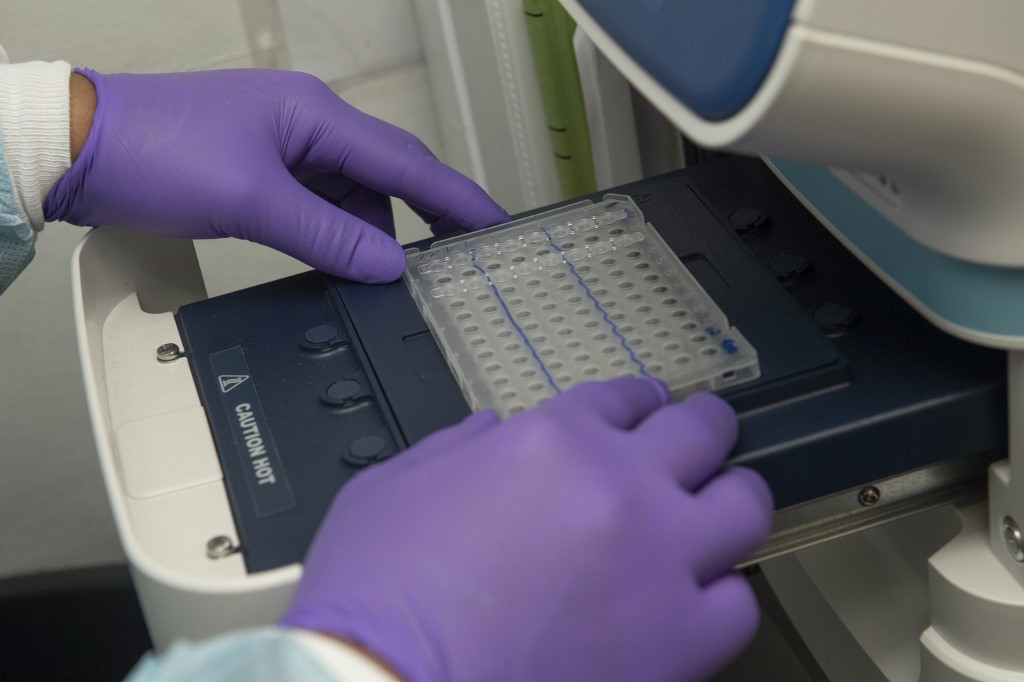Popular Reads
Top Results
Can't find what you're looking for?
View all search resultsPopular Reads
Top Results
Can't find what you're looking for?
View all search resultsUS Navy captain says carrier faces dire coronavirus threat
Change text size
Gift Premium Articles
to Anyone
 This US Navy handout photo obtained on Tuesday shows Hospital Corpsman 1st Class Ernesto Santa Ana, assigned to Naval Medical Research Center, loading a sample into an ABI StepOne Plus RT-PCR machine with samples for complex surveillance testing for COVID-19 in Naval Medical Research Center's mobile laboratory aboard the aircraft carrier USS Theodore Roosevelt (CVN 71), on March 19, 2020 in the Philippine Sea. - The Theodore Roosevelt Carrier Strike Group is on a scheduled deployment to the Indo-Pacific. The captain of the nuclear aircraft carrier with more than 100 sailors infected with the coronavirus pleaded on March 30, 2020 with US Navy officials for resources to allow isolation of his entire crew, and avoid possible deaths in a situation he described as quickly deteriorating. (AFP/Kaylianna GENIER / Navy Office of Information )
This US Navy handout photo obtained on Tuesday shows Hospital Corpsman 1st Class Ernesto Santa Ana, assigned to Naval Medical Research Center, loading a sample into an ABI StepOne Plus RT-PCR machine with samples for complex surveillance testing for COVID-19 in Naval Medical Research Center's mobile laboratory aboard the aircraft carrier USS Theodore Roosevelt (CVN 71), on March 19, 2020 in the Philippine Sea. - The Theodore Roosevelt Carrier Strike Group is on a scheduled deployment to the Indo-Pacific. The captain of the nuclear aircraft carrier with more than 100 sailors infected with the coronavirus pleaded on March 30, 2020 with US Navy officials for resources to allow isolation of his entire crew, and avoid possible deaths in a situation he described as quickly deteriorating. (AFP/Kaylianna GENIER / Navy Office of Information )
T
he captain of the US nuclear-powered aircraft carrier Theodore Roosevelt told the Pentagon that new coronavirus is spreading uncontrollably through his ship and called for immediate help to quarantine its crew.
But Defense Secretary Mark Esper on Tuesday ruled out evacuating the ship, whose plight bears similarities to that on civilian cruise ships where the COVID-19 illness spread.
Captain Brett Crozier wrote in a four-page letter that they had not been able to stem the spread of COVID-19 through the 4,000 crewmembers, describing a dire situation aboard the vessel now docked at Guam, a US territory in the Pacific.
"We are not at war. Sailors do not need to die," Crozier wrote, according to the San Francisco Chronicle, which published a copy of the letter on Tuesday.
"The spread of the disease is ongoing and accelerating," Crozier wrote, referring to the ship's "inherent limitations of space."
He asked to be able to quarantine nearly the entire crew onshore at Guam, saying keeping them all on board the ship was an "unnecessary risk."
There is little opportunity for "social distancing", which US civilians have been told to practice, among the cramped passageways and sleeping quarters of an aircraft carrier.
"Removing the majority of personnel from a deployed US nuclear aircraft carrier and isolating them for two weeks may seem like an extraordinary measure," he said. "This is a necessary risk."
Asked on the CBS Evening News whether it was time for an evacuation, Esper said: I don't think we're at that point."
He added that supplies and medical assistance are being moved out to the Roosevelt.
"We're providing additional medical personnel as they need it."
He added that "none of them are seriously ill" and the Navy is "trying to make sure that we contain the virus, that we deploy testing kits. We get a good assessment of how much of the crew is infected."
Over 100 cases on board
The Chronicle said that more than 100 aboard the warship had been confirmed infected with the new coronavirus, around four times the figures given last Friday.
Crozier asked in the letter for quarantine facilities for the entire crew on Guam.
The US Navy did not confirm the contents of the letter, which were also reported by The New York Times.
In a statement, a Navy official under condition of anonymity said that Crozier had alerted his Pacific fleet leaders on Sunday of the problems aboard the carrier.
"The ship's commanding officer advocated for housing more members of the crew in facilities that allow for better isolation," the official said.
"Navy leadership is moving quickly to take all necessary measures to ensure the health and safety of the crew of USS Theodore Roosevelt, and is pursuing options to address the concerns raised by the commanding officer."
Vietnam port stop
Some speculated that the infection could have begun with a port stop in Vietnam by the Roosevelt.
The carrier put in to Da Nang port for five days in early March, when the virus was raging in China and more than a dozen cases had been detected in Vietnam.
Acting Navy Secretary Thomas Modly told CNN Tuesday that he agreed with Crozier on the seriousness of the situation, and that they had been working over the past few days to move people off of the Roosevelt.
However, he said, facilities to sequester the afflicted sailors in Guam, which hosts a major US naval base, are limited.
"We are having to talk to the government there to see if we can get some hotel space, create some tent-type facilities there," Modly said.
In his letter published by the Chronicle, Crozier referred to a study about the Diamond Princess cruise ship which was quarantined off Japan earlier this year.
The study concluded that early evacuation of passengers and crew would have prevented many more infections. Ten passengers died and more than 700 people who were on board contracted the virus.









